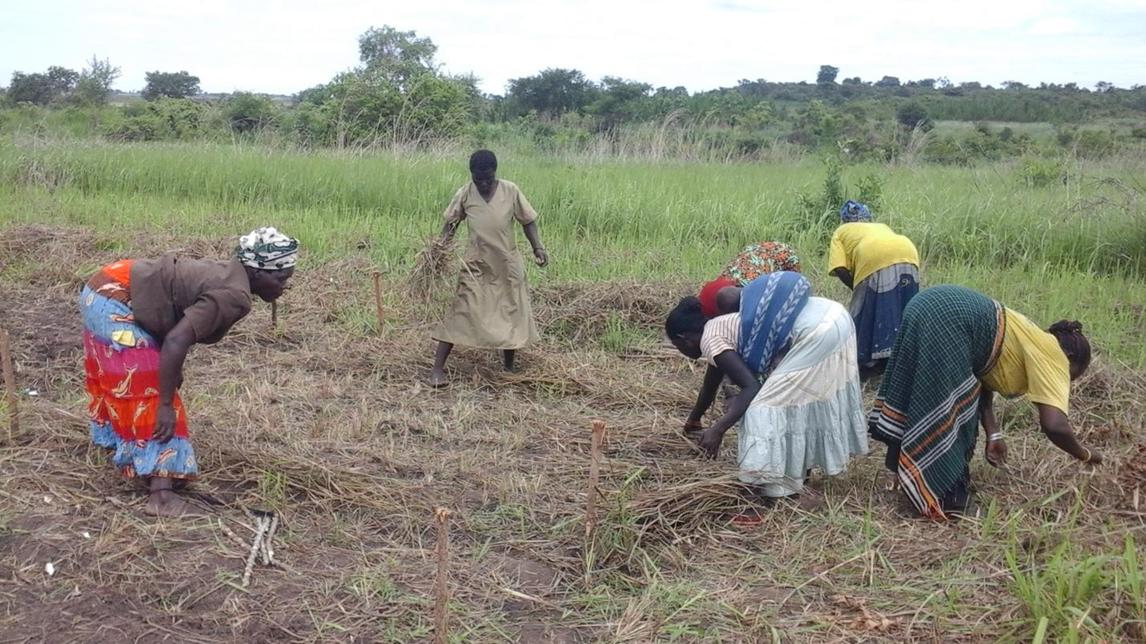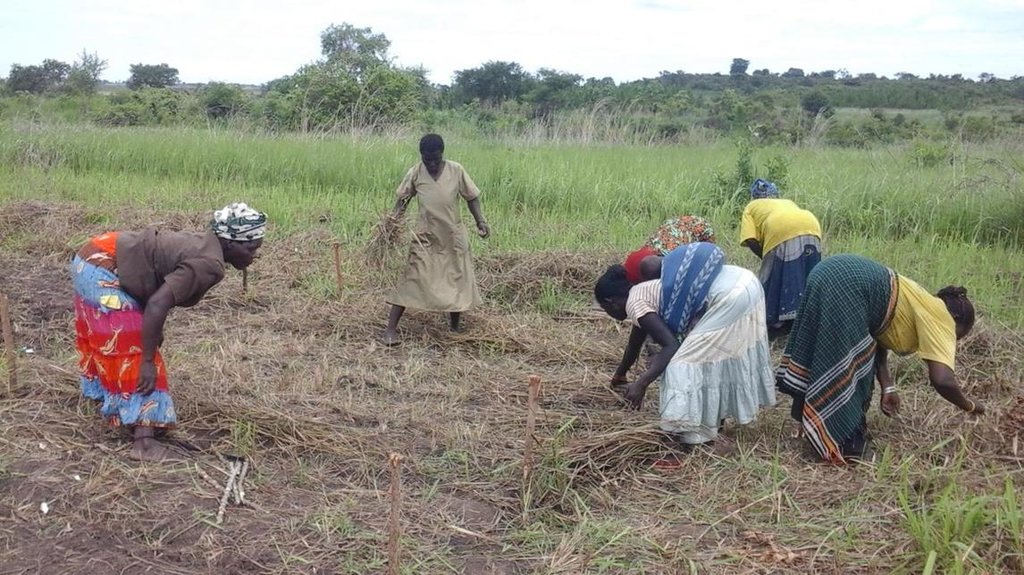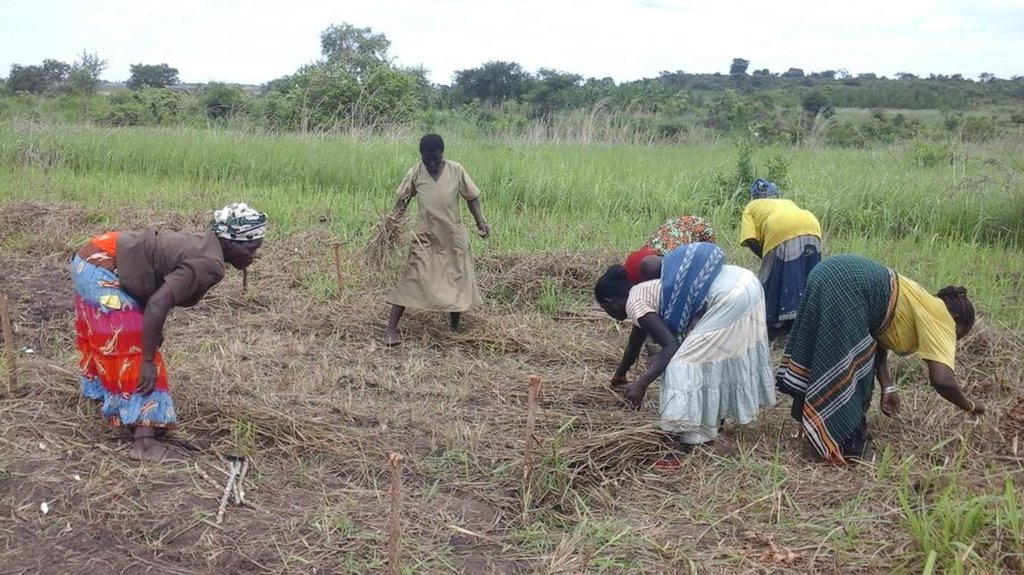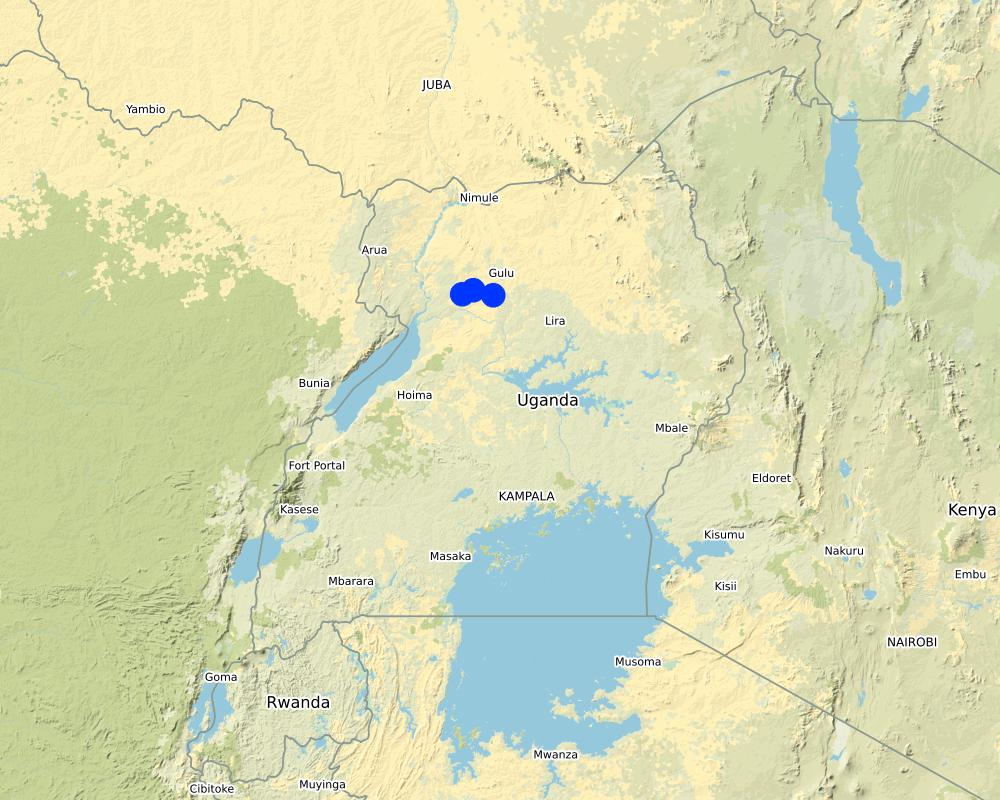Reducing Tillage by Slashing [Uganda]
- Creation:
- Update:
- Compiler: Sunday Balla Amale
- Editors: Kamugisha Rick Nelson, JOY TUKAHIRWA, betty adoch, Bernard Fungo
- Reviewers: John Stephen Tenywa, Nicole Harari, Luigi Piemontese, Udo Höggel
lum ajwera
technologies_3329 - Uganda
View sections
Expand all Collapse all1. General information
1.2 Contact details of resource persons and institutions involved in the assessment and documentation of the Technology
Key resource person(s)
land user:
Aryemo Eveline
Farmer
Obul Village, Lii Sub county, Nwoya District
Uganda
Name of project which facilitated the documentation/ evaluation of the Technology (if relevant)
Scaling-up SLM practices by smallholder farmers (IFAD)Name of the institution(s) which facilitated the documentation/ evaluation of the Technology (if relevant)
Makerere University (Makerere University) - Uganda1.3 Conditions regarding the use of data documented through WOCAT
When were the data compiled (in the field)?
12/07/2017
The compiler and key resource person(s) accept the conditions regarding the use of data documented through WOCAT:
Yes
1.4 Declaration on sustainability of the described Technology
Is the Technology described here problematic with regard to land degradation, so that it cannot be declared a sustainable land management technology?
No
2. Description of the SLM Technology
2.1 Short description of the Technology
Definition of the Technology:
A minimum tillage technology where the garden is cleared by slashing and crops are planted without opening the land. Only the spot where the seed is planted is dug. The rest of the land is left undisturbed.
2.2 Detailed description of the Technology
Description:
Soil tillage, which is practiced traditionally to prepare fine seedbeds and control weeds, bears several undesirable side effects that have forced land users to rethink and develop other sustainable management strategies such as reduced tillage or no-till (see photo below). Tillage as a practice damages soil and leaves it exposed to erosion, particularly by wind and water. Yet weeding using tillage methods is often laborious and costly. In parts of northern Uganda, minimum or reduced tillage is used to ease land preparation.
Labor is an important factor that determines the size of gardens that farmers can prepare and work on. With this technology, immediately after crop harvest, the field is cleared by slashing residues (weeds and crop residues) present in the field. It is a good practice to cut the vegetation before they produce seeds to ensure that few weed seeds germinate. After slashing down crop residues, planting holes for the subsequent crop are dug following the given recommendations for the crop to be planted.
This practice ensures that the residues provide mulch, which in turn reduces surface runoff and soil erosion. The decomposing residues provide humus and replenish nutrients into the soil. Plants can also escape harsh weather conditions since they can be planted in time. This technology is still new among the farming communities in northern Uganda, thus its proper use requires extension advisory support.
2.3 Photos of the Technology
2.5 Country/ region/ locations where the Technology has been applied and which are covered by this assessment
Country:
Uganda
Region/ State/ Province:
Nothern
Further specification of location:
Nwoya district
Comments:
The three sites in Nwoya were demonstrations established by CIAT/IITA on CSA practices which included minimun tillage
Map
×2.6 Date of implementation
Indicate year of implementation:
2015
2.7 Introduction of the Technology
Specify how the Technology was introduced:
- through land users' innovation
- through projects/ external interventions
3. Classification of the SLM Technology
3.1 Main purpose(s) of the Technology
- improve production
- conserve ecosystem
- preserve/ improve biodiversity
- adapt to climate change/ extremes and its impacts
- create beneficial economic impact
- ensure early planting
3.2 Current land use type(s) where the Technology is applied

Cropland
- Annual cropping
3.3 Further information about land use
Water supply for the land on which the Technology is applied:
- rainfed
Number of growing seasons per year:
- 2
Specify:
Two rainy seasons
3.4 SLM group to which the Technology belongs
- improved ground/ vegetation cover
- minimal soil disturbance
3.5 Spread of the Technology
Specify the spread of the Technology:
- applied at specific points/ concentrated on a small area
3.6 SLM measures comprising the Technology

agronomic measures
- A1: Vegetation/ soil cover

vegetative measures
- V2: Grasses and perennial herbaceous plants
3.7 Main types of land degradation addressed by the Technology

soil erosion by water
- Wt: loss of topsoil/ surface erosion

soil erosion by wind
- Et: loss of topsoil

chemical soil deterioration
- Cn: fertility decline and reduced organic matter content (not caused by erosion)

biological degradation
- Bh: loss of habitats
- Bq: quantity/ biomass decline
- Bl: loss of soil life
3.8 Prevention, reduction, or restoration of land degradation
Specify the goal of the Technology with regard to land degradation:
- reduce land degradation
- adapt to land degradation
4. Technical specifications, implementation activities, inputs, and costs
4.2 Technical specifications/ explanations of technical drawing
Grasses are slashed to ground surface. Only the spot onwhich the seed is to be planted is dug to create conditions for good germination.
4.3 General information regarding the calculation of inputs and costs
Specify how costs and inputs were calculated:
- per Technology unit
Specify unit:
acre
Specify volume, length, etc. (if relevant):
30x160m2
other/ national currency (specify):
uganda shillings
Indicate exchange rate from USD to local currency (if relevant): 1 USD =:
3600.0
Indicate average wage cost of hired labour per day:
5000
4.4 Establishment activities
| Activity | Type of measure | Timing | |
|---|---|---|---|
| 1. | Slashing | Management | dry season |
Comments:
This is an activity in replacement to land preparation by tillage
4.5 Costs and inputs needed for establishment
| Specify input | Unit | Quantity | Costs per Unit | Total costs per input | % of costs borne by land users | |
|---|---|---|---|---|---|---|
| Labour | Personnel | persondays | 9.0 | 5000.0 | 45000.0 | 100.0 |
| Equipment | Slashes | pieces | 3.0 | 6000.0 | 18000.0 | 100.0 |
| Total costs for establishment of the Technology | 63000.0 | |||||
Comments:
Farmer can use hoes instead of slasher for slashing the grass. If grasses are tall and mature, the farmer prefers to use a hand hoe of equivalent cost
4.6 Maintenance/ recurrent activities
Comments:
This technology is not maintained, it is repeated. That is it is to be done prior to every planting season.
4.7 Costs and inputs needed for maintenance/ recurrent activities (per year)
Comments:
This technology is not maintained, it is repeated every season
4.8 Most important factors affecting the costs
Describe the most determinate factors affecting the costs:
Farm labour, although this technology reduces the labour demand in general
5. Natural and human environment
5.1 Climate
Annual rainfall
- < 250 mm
- 251-500 mm
- 501-750 mm
- 751-1,000 mm
- 1,001-1,500 mm
- 1,501-2,000 mm
- 2,001-3,000 mm
- 3,001-4,000 mm
- > 4,000 mm
Specifications/ comments on rainfall:
Two rainy seasons in a year, dry season between December and March
Indicate the name of the reference meteorological station considered:
Gulu Meteorological Station
Agro-climatic zone
- sub-humid
5.2 Topography
Slopes on average:
- flat (0-2%)
- gentle (3-5%)
- moderate (6-10%)
- rolling (11-15%)
- hilly (16-30%)
- steep (31-60%)
- very steep (>60%)
Landforms:
- plateau/plains
- ridges
- mountain slopes
- hill slopes
- footslopes
- valley floors
Altitudinal zone:
- 0-100 m a.s.l.
- 101-500 m a.s.l.
- 501-1,000 m a.s.l.
- 1,001-1,500 m a.s.l.
- 1,501-2,000 m a.s.l.
- 2,001-2,500 m a.s.l.
- 2,501-3,000 m a.s.l.
- 3,001-4,000 m a.s.l.
- > 4,000 m a.s.l.
Indicate if the Technology is specifically applied in:
- not relevant
5.3 Soils
Soil depth on average:
- very shallow (0-20 cm)
- shallow (21-50 cm)
- moderately deep (51-80 cm)
- deep (81-120 cm)
- very deep (> 120 cm)
Soil texture (topsoil):
- medium (loamy, silty)
Soil texture (> 20 cm below surface):
- fine/ heavy (clay)
Topsoil organic matter:
- medium (1-3%)
5.4 Water availability and quality
Ground water table:
5-50 m
Availability of surface water:
medium
Water quality (untreated):
poor drinking water (treatment required)
Is water salinity a problem?
No
Is flooding of the area occurring?
No
5.5 Biodiversity
Species diversity:
- medium
Habitat diversity:
- medium
5.6 Characteristics of land users applying the Technology
Sedentary or nomadic:
- Sedentary
Market orientation of production system:
- subsistence (self-supply)
Off-farm income:
- less than 10% of all income
Relative level of wealth:
- poor
Individuals or groups:
- individual/ household
Level of mechanization:
- manual work
Gender:
- women
Age of land users:
- youth
- middle-aged
5.7 Average area of land owned or leased by land users applying the Technology
- < 0.5 ha
- 0.5-1 ha
- 1-2 ha
- 2-5 ha
- 5-15 ha
- 15-50 ha
- 50-100 ha
- 100-500 ha
- 500-1,000 ha
- 1,000-10,000 ha
- > 10,000 ha
Is this considered small-, medium- or large-scale (referring to local context)?
- small-scale
5.8 Land ownership, land use rights, and water use rights
Land ownership:
- individual, not titled
Land use rights:
- individual
Water use rights:
- communal (organized)
5.9 Access to services and infrastructure
health:
- poor
- moderate
- good
education:
- poor
- moderate
- good
technical assistance:
- poor
- moderate
- good
employment (e.g. off-farm):
- poor
- moderate
- good
markets:
- poor
- moderate
- good
energy:
- poor
- moderate
- good
roads and transport:
- poor
- moderate
- good
drinking water and sanitation:
- poor
- moderate
- good
financial services:
- poor
- moderate
- good
6. Impacts and concluding statements
6.1 On-site impacts the Technology has shown
Socio-economic impacts
Production
crop production
Comments/ specify:
More land can be opened
crop quality
Comments/ specify:
Better crop growth
production area
Quantity before SLM:
1acre
Quantity after SLM:
2acre
Comments/ specify:
more land can be opened
land management
Comments/ specify:
Reduced soil erosion
Income and costs
expenses on agricultural inputs
Comments/ specify:
Less expenses on land opening
farm income
Comments/ specify:
due to increased production
workload
Comments/ specify:
Primary and secondary tillage reduced to just slashing
6.2 Off-site impacts the Technology has shown
water availability
Comments/ specify:
Grasses retain more water so that more water is in the soils
6.3 Exposure and sensitivity of the Technology to gradual climate change and climate-related extremes/ disasters (as perceived by land users)
Gradual climate change
Gradual climate change
| Season | Type of climatic change/ extreme | How does the Technology cope with it? | |
|---|---|---|---|
| annual rainfall | decrease | very well | |
| seasonal rainfall | wet/ rainy season | decrease | well |
Climate-related extremes (disasters)
Climatological disasters
| How does the Technology cope with it? | |
|---|---|
| drought | very well |
Biological disasters
| How does the Technology cope with it? | |
|---|---|
| insect/ worm infestation | moderately |
6.4 Cost-benefit analysis
How do the benefits compare with the establishment costs (from land users’ perspective)?
Short-term returns:
positive
Long-term returns:
very positive
How do the benefits compare with the maintenance/ recurrent costs (from land users' perspective)?
Short-term returns:
positive
Long-term returns:
very positive
Comments:
In real sense, this technology its not maintained but it is done each and every season for annual crops for land clearence
6.5 Adoption of the Technology
- 1-10%
Of all those who have adopted the Technology, how many have did so spontaneously, i.e. without receiving any material incentives/ payments?
- 90-100%
6.6 Adaptation
Has the Technology been modified recently to adapt to changing conditions?
No
6.7 Strengths/ advantages/ opportunities of the Technology
| Strengths/ advantages/ opportunities in the land user’s view |
|---|
| Reduction of labour demands |
| More land can be cleared |
| Less farm activities |
| Strengths/ advantages/ opportunities in the compiler’s or other key resource person’s view |
|---|
| Reduction in soil disturbance hence increase in soil life |
6.8 Weaknesses/ disadvantages/ risks of the Technology and ways of overcoming them
| Weaknesses/ disadvantages/ risks in the land user’s view | How can they be overcome? |
|---|---|
| more weeds | proper control of weeds, before they produce seeds |
| Weaknesses/ disadvantages/ risks in the compiler’s or other key resource person’s view | How can they be overcome? |
|---|---|
| Leached nutrients are not brought to surface | plant deep rooted crops |
7. References and links
7.1 Methods/ sources of information
- field visits, field surveys
3
- interviews with land users
1
- interviews with SLM specialists/ experts
1
Links and modules
Expand all Collapse allLinks
No links
Modules
No modules





